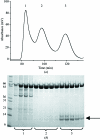Purification, crystallization and preliminary crystallographic analysis of the Hermes transposase
- PMID: 16511103
- PMCID: PMC1952326
- DOI: 10.1107/S1744309105015721
Purification, crystallization and preliminary crystallographic analysis of the Hermes transposase
Abstract
DNA transposition is the movement of a defined segment of DNA from one location to another. Although the enzymes that catalyze transposition in bacterial systems have been well characterized, much less is known about the families of transposase enzymes that function in higher organisms. Active transposons have been identified in many insect species, providing tools for gene identification and offering the possibility of altering the genotypes of natural insect populations. One of these active transposons is Hermes, a 2749-base-pair element from Musca domestica that encodes its own transposase. An N-terminally deleted version of the Hermes transposase (residues 79-612) has been overexpressed and purified, and crystals that diffract to 2.1 A resolution have been obtained at 277 K by the hanging-drop method.
Figures



Similar articles
-
Structural basis of hAT transposon end recognition by Hermes, an octameric DNA transposase from Musca domestica.Cell. 2014 Jul 17;158(2):353-367. doi: 10.1016/j.cell.2014.05.037. Cell. 2014. PMID: 25036632 Free PMC article.
-
Hermes transposon distribution and structure in Musca domestica.J Hered. 2009 Jul-Aug;100(4):473-80. doi: 10.1093/jhered/esp017. Epub 2009 Apr 14. J Hered. 2009. PMID: 19366812 Free PMC article.
-
Expression, purification and preliminary crystallographic studies of a single-point mutant of Mos1 mariner transposase.Acta Crystallogr D Biol Crystallogr. 2004 May;60(Pt 5):962-4. doi: 10.1107/S0907444904003798. Epub 2004 Apr 21. Acta Crystallogr D Biol Crystallogr. 2004. PMID: 15103153
-
[Modification and decoration of transposase: a review].Sheng Wu Gong Cheng Xue Bao. 2014 Oct;30(10):1504-14. Sheng Wu Gong Cheng Xue Bao. 2014. PMID: 25726575 Review. Chinese.
-
Transposase concentration controls transposition activity: myth or reality?Gene. 2013 Nov 10;530(2):165-71. doi: 10.1016/j.gene.2013.08.039. Epub 2013 Aug 28. Gene. 2013. PMID: 23994686 Review.
Cited by
-
Sequence Analysis of the Segmental Duplication Responsible for Paris Sex-Ratio Drive in Drosophila simulans.G3 (Bethesda). 2011 Oct;1(5):401-10. doi: 10.1534/g3.111.000315. Epub 2011 Oct 1. G3 (Bethesda). 2011. PMID: 22384350 Free PMC article.
-
Transposase subunit architecture and its relationship to genome size and the rate of transposition in prokaryotes and eukaryotes.Nucleic Acids Res. 2018 Oct 12;46(18):9637-9646. doi: 10.1093/nar/gky794. Nucleic Acids Res. 2018. PMID: 30184164 Free PMC article.
-
Structural insights into the mechanism of double strand break formation by Hermes, a hAT family eukaryotic DNA transposase.Nucleic Acids Res. 2018 Nov 2;46(19):10286-10301. doi: 10.1093/nar/gky838. Nucleic Acids Res. 2018. PMID: 30239795 Free PMC article.
References
-
- Aravind, L. (2000). Trends Biochem. Sci.25, 421–423. - PubMed
-
- Bigot, Y., Augé-Gouillou, C. & Periquet, G. (1996). Gene, 174, 265–271. - PubMed
-
- Calvi, B. R., Hong, T. J., Findley, S. D. & Gelbart, W. M. (1991). Cell, 66, 465–471. - PubMed
-
- Chaconas, G. & Harshey, R. M. (2002). Mobile DNA II, edited by N. L. Craig, R. Craigie, M. Gellert & A. M. Lambowitz, pp. 384–402. Washington DC: American Society of Microbiology.
-
- Dyda, F., Hickman, A. B., Jenkins, T. M., Engelman, A., Craigie, R. & Davies, D. R. (1994). Science, 266, 1981–1986. - PubMed
MeSH terms
Substances
LinkOut - more resources
Full Text Sources
Other Literature Sources

